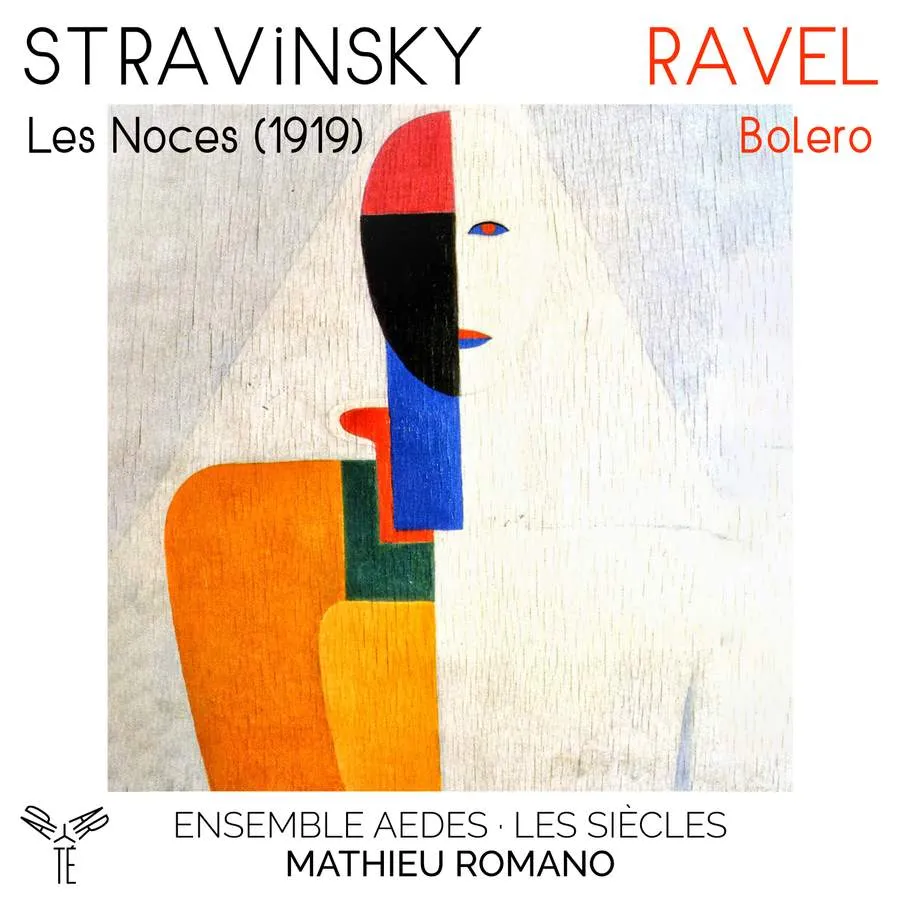
Ravel • Stravinsky Ravel: Bolero (arr. Melchior); Stravinsky: Les Noces (1919 version, completed Verbey); Trad: Ne vesiolaia... Ensemble Aedes; musicians of Les Siècles/Mathieu Romano Aparté AP300 40:50 mins
Of all his ballets, Stravinsky’s Les Noces – an evocation of Russian peasant wedding rituals – was the one he laboured over longest as he changed his mind several times about its instrumentation. Here, for the first time, is a recording of the entire ballet-cantata using the line-up Stravinsky favoured but reluctantly abandoned in 1919.
Stravinsky had made at least two previous false starts. One of these, for 36 solo musicians including a cimbalom player, was virtually fully sketched out by 1917 (Robert Craft recorded a realisation of that version in 1973). After that attempt, Stravinsky then conceived an even smaller ensemble: harmonium, a pair of cimbaloms, various drums and bells, and a pianola, an instrument that he admired for its impersonal and mechanical precision. By late 1919, he had completely scored the first two of the work’s four tableaus for that instrumentation. But then, having recognised the difficulties of co-ordinating a pianola with live performers, he reconceived his score for the now-familiar ensemble of four pianos and percussion, completing this in 1923.
Most previous attempts to perform the two extant tableaus of 1919 have replaced the pianola with four-hand piano (as in Robert Craft’s recording); Pierre Boulez alone braved the use of a pianola in his landmark performance in 1981. This new recording, however, by Mathieu Romano conducting the combined forces of Ensemble Aedes and musicians of Les Siècles – using a computer-controlled pianola – is the very first to present the entire work in Stravinsky’s favoured 1919 instrumentation, as convincingly completed by the late Dutch composer Theo Verbey.
The difference is immediately telling. Instead of the chiming and crystalline accompaniment familiar from the 1923 version, we hear the earthier sounds of the two cymbaloms and harmonium which, with the pianola, accompany the opening soprano lament. The chorus and vocal soloists – no longer competing with the final version’s four pianos and the brightly ringing percussion instruments (such as xylophone) – are more effectively integrated in this folklike and rustic-sounding instrumental ensemble.
All that said, the pianola’s mechanistic and inexorable tempo drives much of the performance, effectively depersonalising the ritual while sharpening the rhythmic profile of much of the music. Yet the Ensemble Aedes and its various soloists, even while working with the pianola’s relentless drive, admirably characterise their singing, one moment full of rough enthusiasm or raw emotion, the next beguilingly lyrical.
Hearing Stravinsky’s long-desired but originally unfulfilled version of Les Noces – so compellingly realised between Verbey and these fine musicians – is worth the price of entry alone. But the album also offers, as preface, an authentic folk-style performance of the Russian folksong ‘Ne vesiolaia...’, known to have inspired Les Noces. Stravinsky’s ballet itself is then followed by an arrangement (by Robin Melchior) of Ravel’s Bolero for the same instrumental and vocal forces – a curious experiment which, in the absence of the original instrumentation, highlights the inventive variations of texture as it crescendos to its climax.
Daniel Jaffé
